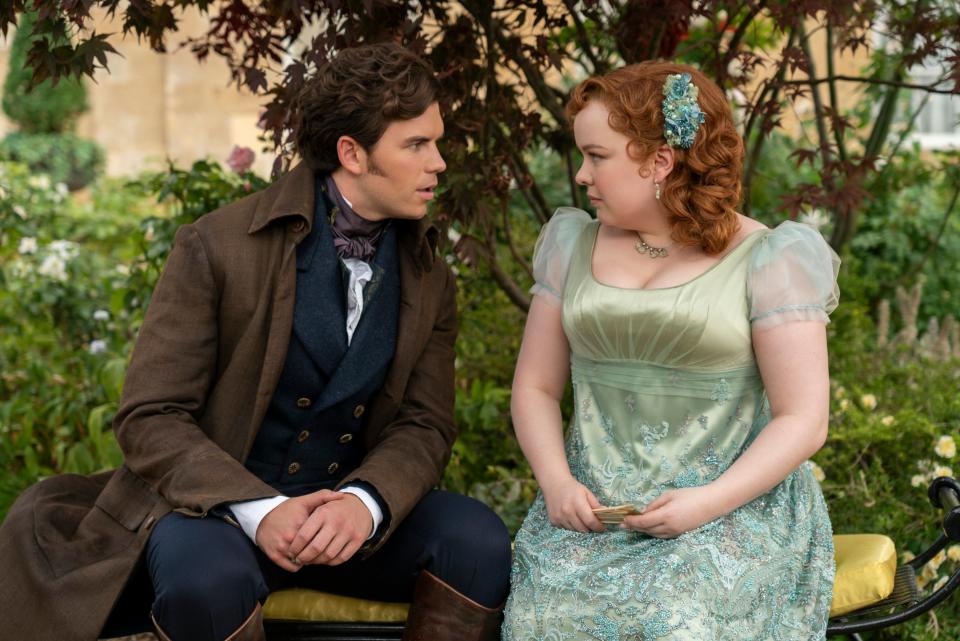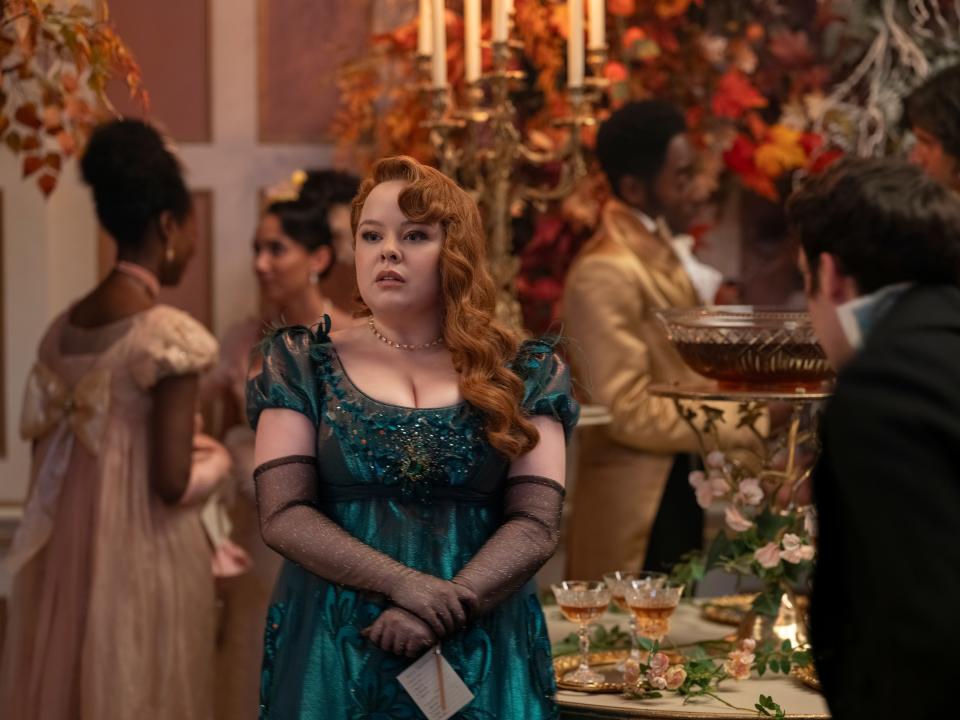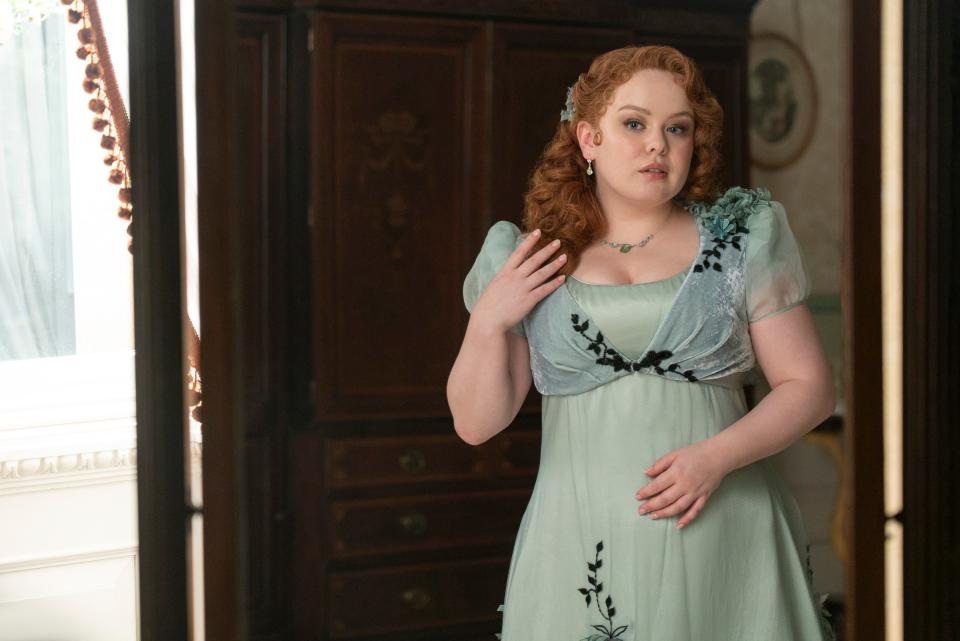Bridgerton Costume Designer John Glaser on Penelope Featherington's Makeover, Regency, and More

- Oops!Something went wrong.Please try again later.
LIAM DANIEL/NETFLIX
Dearest readers, Bridgerton is back and as decadent as ever. The third installment of this period-drama sees wallflower, Penelope Featherington, played by Nicola Coughlan, come into bloom. Tired of being the resident spinster amongst the Ton, Penelope sets out to improve her prospects on the marriage mart, by reinventing her entire wardrobe.
As dictated by Julia Quinn’s novels of the same name, the Featheringtons have one of the tawdrier color palettes in the show of sickly-sweet oranges, yellows and greens. Compared to the sumptuous Bridgerton blues and the opulent cream and gold hues that the ladies of the Ton are bathed in, it’s led Penelope to stand out — and not in a good way.
In the first episode of season three, Penelope becomes embarrassed by her own irrelevance in society and decides it’s time for a change. In the modiste, she declares: “I do not wish to see a citrus color ever again.” Cue a major makeover, which sees the social wallflower swap out her garish garments for sensual pastel gowns with delicate embellishments and a flattering square-cut neckline.
Known for her garish yellow frumpy frocks, feathered headpieces and extravagant jewelry, Penelope blossoms from an overlooked younger sister to a desirable woman through a remarkable style evolution by costumes designer John Glaser.
Glaser, who previously worked alongside Ellen Mirojnick to curate the impeccable wardrobe in season one, was conscious of the delicate challenge at hand. Reimagining Penelope’s wardrobe could not come at the cost of losing the strong character that had already been established across the first two seasons.
While preparing an estimated 40 gowns for the new season, Glaser wanted to create a new feminine silhouette for Penelope that flattered her figure. He said: “Our mission was to showcase her body, instead of trying to hide it with the regency line. We wanted to show that she's not a girl, she's a woman.”
For season three, it was essential that her outfits were “sexy, alluring and strong” and Glaser felt the “weight” of that expectation to reinvent this established character in a way that was authentic and in-keeping with the show’s rich aesthetic. Not only had Penelope matured, but her lifelong friend and secret crush, Colin Bridgerton, played by Luke Newton, has too, and the duo begin to see each other in a whole new light.

“She had to bounce off of a new Colin too, and visually, it had to happen very quickly,” he continued. “It was a challenge to make sure that it was right. It takes a little while to get to that point, but then all of a sudden everyone — the people that are making the clothes, the actor — all of us all go, ‘Oh, that's it.’”
The former overlooked Bridgerton brother also looks different this season. Long gone is the boyish side burns, replaced is a rugged, weathered, well-travelled man. Colin is grounded in earthier, “darker tones of browns” and dressed in stronger, vivid patterns.
For Penelope’s reintroduction to the Ton, Glaser compounded the reimagination of her character into one dramatic gown, which embodied everything “she’s never worn before all-in-one dress.” Enter that deep emerald, gold embellished gown with matching black sheer elbow-length gloves.
“She’s never worn a dark color, layers of fabric or metallics like that before, so we thought this was a chance to do that,” Glaser adds. “It was influenced from fashion in Paris at that time and that dress was good for that moment, but to follow that pattern for the rest of her clothes throughout the season would have been a detriment to all of us.”

Vivid, rich greens, though striking against Coughlan’s fair skin and her character’s copper locks, would become “tiresome” if it became Penelope’s staple shade. Similar to being showered in sunshine yellow in the first two seasons, the powerful effect of the bold hues in amongst the pastel garden tones, loses its impact.
Glaser also notes that when designing Penelope’s new wardrobe, he couldn’t encroach on the existing color associations in the show.
“We softened her colors and used blue and green together, little bit of pinks, touches of yellow,” he continues. “We didn’t want to place Easter gggs for people to think ‘Oh, this blue dress means she’s going to be a Bridgerton.’ I wanted to keep all the costumes a little mysterious because they were all changing and evolving.”
Light and ethereal, Penelope’s new color palette embodied the natural essence of a flower to feel organic and reinforce her flourishing character. The color of her gowns was also a process of elimination, as Glaser had to avoid the Bridgerton blues and those former citrus shades.
“Her color palette was actually the one Colin used to wear in season one and two, with those light colors. They’ve both grown older and their lives have matured,” he shared. “We layered fabrics together to make a color, so if someone asks what color that dress is, most people have three or four opinions on it, because it depends on how you look at it.”
The color of Penelope’s costumes is open for interpretation, similar to her character: peel back the layers to discover different aspects of her identity as both the social reject and the revered and respected Lady Whistledown, the pen name she uses for her popular gossip column.

Though Penelope is the central focus of this season, her costumes never detract from the rest of the scene. Our wallflower blooms and blends into the rest of the Bridgerton flower garden, which the costumes are based on. No longer the direct contrast to her friends, she subtly compliments her surroundings and only stands out now for the ornate, intricate detailing in the embellishments of her gowns. She is opulent and abundant, not overpowered by her clothing. Adorned with beaded flowers or dainty lace gloves and sheer wraps, Penelope is elevated above the average woman’s appearance this season but in an understated way.
“There is some planning in that,” Glaser explains. “If we're doing a scene in, say, a library — one time she is there and she is wearing blue — then we keep most of the blue out of that scene.”
One of the main challenges with Penelope’s style evolution was to make sure her new attire didn’t overshadow Coughlan’s performance. He adds: “She is the main character and because of that, you see her so much, so we had to pull ourselves back sometimes and not overdress her. You want her character to be at the forefront, and we are just there to enhance it.”
The final episode in part one of season three is stuffed with surprises, which mirrors the bolder fashion choices this season. As effortless as the Bridgerton aesthetic seems, it is a tribute to the creative team’s tireless dedication to find new artistic ways to explore regency fashion. The contemporary aspects of the series — such as the orchestral versions of Taylor Swift or Ariana Grande hits, or the lower necklines — have to compliment and derive from the historical influences.
“Everything is based on the Regency period, but you only need a few items,” he says. “You need a high waistline, a skirt that's like a column, and then we just veer off from that.”
“There are many times that we go too far and it doesn’t even resemble regency, so we stop and say ‘All right, what’s going wrong?’ We always go back to what the core of regency is.”
After admiring the intricate work of the artists on Bridgerton, it’s safe to say that Glaser (and his design team) have exceeded our expectations to deliver a rich tapestry of style and tastes to serve as the backdrop for the beloved, romantic drama that the series is renowned for.
Originally Appeared on Teen Vogue
Want more style stories from Teen Vogue? Check these out:

